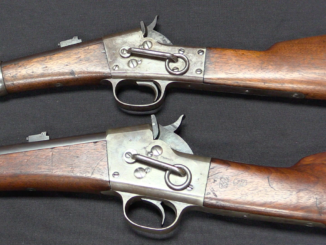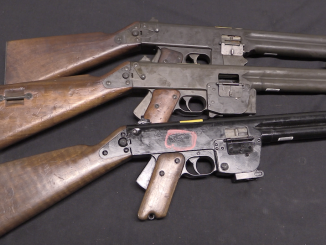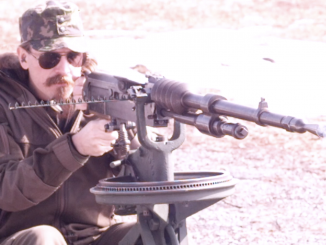This is a really interesting artifact of the First World War that I found in a collection and wanted to share (since the owner, understandably, wouldn’t part with it!). All the major powers in the Great War set up aerial training schools to teach pilots and observer/gunners how to use their guns without having to be up in the air. These often included mocked-up cockpits and gun mounts which could be towed to enable practice while moving.
The Vickers Gun we are looking at today began its life as an aircraft gun, with the water jacket cut away to allow air cooling and reduce weight. It appears that a French training base needed a training gun with an intact water jacket for extended firing (the air cooling doesn’t work so well when the gun is essentially static on the ground). Unable to procure a new standard ground Vickers, an armorer spent a significant amount of time re-sealing the jacket on an aircraft gun instead. A major clue to its purpose is the French-language tag riveted to the back of the jacket warning users to ensure that the oscillating arm doesn’t hit the jacket – this indicates that it was set up with a firing mechanism to duplicate the synchronizers used on aircraft.
Unfortunately, the gun was disassembled at some point and all the detachable parts removed, along with the right-hand side plate of the receiver (the part that is legally a machine gun in the US). However, the jacket and remnants of the receiver remain a really interesting artifact, to me at least…




How did they simulate aerial targets flying across the pilot’s flight path? The other team isn’t going to sit still, you know.
Drag the pilot/machinegun carriage across the field one way, drag an armored plate (or bamboo German plane mockup) across the field the other way?
Since Ian does seem to have all the requisite missing bits in his lap, why not temporarily reequip the French gun w/ all the bits, Karl can drive an armored car across the field and Ian can give us a shooting demonstration?
I suppose you are joking? Since even if Karl had access to an armored car, it would be almost as stupid an experiment as testing body armor with a someone actually wearing the armor…
Not at all. We do stuff like that all the time.
Do you doubt Karl would do such a thing if he had an armored car? A friend of mine has such a thing, but keeping it running, alas…
Ground machine gun were used to teah how to operate the gun, arming the machine gun, short burst, clearing the gun after a malfunction… Manual says that when training on the ground accuracy is not an objective. In the air they used tracted targets (windsock).
Also, already WW1 there were attempts to make use of pilotless aeroplanes (drones in 1930s terminology), for example Ruston Proctor Aerial Target see 2nd photo from top https://www.digitaltrends.com/cool-tech/history-of-drones/
but getting enough reliability proved problematic with then available wireless technology
“(…)major powers in the Great War set up aerial training schools to teach(…)observer/gunners how to use their guns without having to be up in the air.(…)”
What might be mind-boggling from today perspective when usage of simulators is widespread, is that during said conflict aeroplanes unable to fly were used for pilot training. Penguin code-name was used by U.S. forces, see 2nd photo from top
https://www.cradleofaviation.org/history/exhibits/exhibit-galleries/world_war_i/breese_penguin.html
Very cool!
Read a first person story of learning to fly using a penguin in the 1915/1916 time period. Author said the instructor got them in a group and explained to them how to start, and fly the penguin (it will hop, not sustained flight). Then he said he was going to the bar and they could all kill themselves for all he cared.
Not something to give one confidence. The author said he didn’t even tell them to take off into the wind (a huge consideration for pilots), they had to figure it out by themselves.
No wonder more of them died in training than in combat.
That kind of instructor would get cashiered today or even fragged.
In terms of training, there was a funny method, when additional protection was installed on an ordinary aircraft and fired at it from ordinary machine guns, cartridges with bullets from zinc(?) alloy.
Interestingly, the pilot of the target was a special person, or at the same time the recruits were taught not to panic under fire?.. 😉
Ah Ian, you unabashed Francophile!
Well done! After a long, colorful and storied career in the military (It’s my career, I can remember it any way I want) I can say with a good degree of certainty that when budgets are made up, and the cash distributed, training is always last in line for the largess. For the training Officer it is always a matter of “make do” with what you are given. I am not a bit surprised to see something like this mechanical monstrosity used in the training environ.
Once again, a cool little snapshot in time
Yes a really great artifact! Here in New Zealand we used to have a whole bunch of German Maxims Originally planning a WW1 memorial Museum in the capital city apparently 1400 (yeah!) were imported to create a “trophy wall” of these things! both 1908 & .08/15 types arrived . BUT slump times & bickering set in & the planned display was shelved(politics?pacificism set in) The guns were sent out in quantity for display in Halls , Parks , & schools!!! all the ones i ever saw were in fair to great working order. Over the years they pretty much disappeared . many years ago I repaired a very rusted relic 08/15 from a local park where it was set up on a concrete block. There was a bullet hole in the top of the jacket with a corresponding dent in the bottom! on emptying the debris a badly mauled bullet emerged also& later a scarred mark on the barrel Assuming the gunner was stumbling forward & bullet trajectory to be horizontal the gun was @ 45% . OR a standing trooper had shot DOWNWARDS Anyways an evocative relic! New Zealand sent 10% of its population to the war !
Could be a victim of ground strafing. Big time job for the RFC/RAF in 1918 and machine gun nests were primo targets.
A Colt made Vickers.